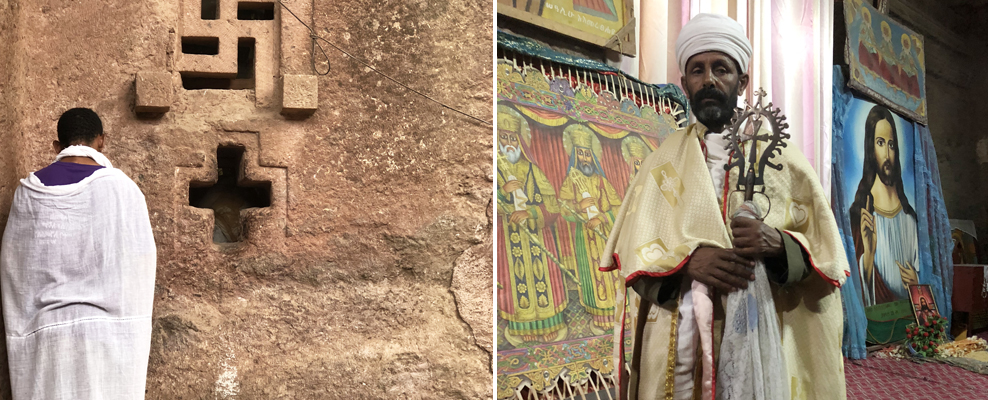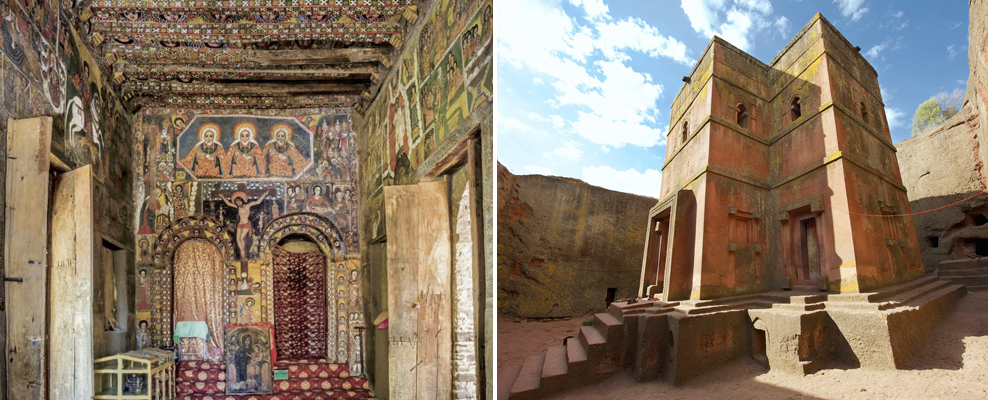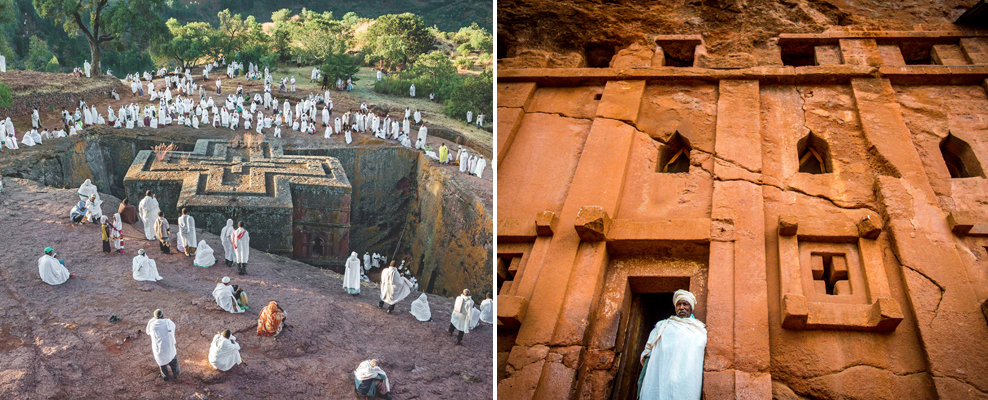When it adopted Christianity in the earlier part of the fourth century, Ethiopia was among the earliest of nations to do so. Some centuries later, Zagwe King Gebre Mesqel Lalibela (circa 1181-1221) made the arduous pilgrimage to Jerusalem. The saint-king returned to Ethiopia with a piece of the Holy Covenant, a casket of oil, and a vision. He would build a New Jerusalem, as Muslim conquest of the Holy Land halted pilgrimage in 1187.
The 11 rock-hewn churches of Lalibela still stand as imposing monolithic rock structures, majestic in their simplicity and sheer power of line and form. Saint George is the most dramatic. Built in the shape of the cross it plunges deep to the ground below and is entered through a side tunnel. Our guide believed the churches were built with the help of angels who worked at night for 89 years.
In Lalibela a deep spirituality emanates from the worn rock, pummeled by the feet of the many worshippers, in which the churches are set.
Each January 6th, the Coptic Christmas, more than 500,000 Ethiopians make the pilgrimage to Lalibela, many by foot as they have done the last 800 years. There were pilgrims to Lalibela who never made the journey back. In Saint George there is an open cave with skeletons of those who came and died in prayer. (They never elaborated more than this).

The road to Lalibela is long. We set out from the provincial town of Dese in the Amhara region on our journey to Lalibela by car. But one can fly directly to Lalibela from Addis Ababa, which is what most tourists do. Up in the Ethiopian highlands the journey was breathtakingly beautiful. It took us 8 and a half-hours to get there through winding mountain roads and dirt tracks that overlooked wide vistas of terraced fields and mountain forests.
The seeming simplicity of Lalibela’s churches evokes the great narratives of the Bible, which, like the Ten Commandments, are encoded in stone. The parting of rock in a small church in the first compound pays homage to the parting of the Red Sea. The five tiers marked on the facade of Saint George, the last Church to be built, references the rising water line during the Great Flood—like Noah’s Ark it narrows as it reaches skyward, built to withstand the weathering of time.
The churches of Lalibela are set next to one another, forming a community of sorts, each a piece of a broader Biblical chronicle. They share a common courtyard, and the visitor moves from one church to the next seamlessly.

Only Saint George stands apart, a five-minute walk away, at a slightly lower elevation. Some of the churches are very large rock structures and some modest, but all have minimal decorative motifs on the outside – a pattern of the Coptic cross featured as a decorative motif on a rock column, and windows that are symbolically shaped to represent, for example, the ascension to heaven or the decline to the underworld.
The interiors of the churches are small and cave-like, with three distinct spaces. The holy of holies, where a piece of the Covenant is placed, is curtained off with ceremonial curtains. A priest in flowing white robes stands in the middle section of each church blessing the worshippers with a wooden cross. He places the cross on the forehead and cheek of the worshipper, who then kisses the base of the cross. There is a third demarcated space where people may huddle.
Worn carpets cover the stone floors. There may be a wooden bench or two, and there are colorful paintings, old and new, of Jesus, Mary and the various stories of the New Testament. Some churches featured patterns and paintings on the walls and dome detailing Biblical stories, most did not. One had a stairway to the upper gallery that was closed to the public.

Many rituals and rites are associated with Lalibela. In the courtyard there is a small algae-filled pool where women still immerse themselves as a fertility rite. One church has graves of the saints carved into the rock, about three feet deep. A wooden oblong object in the shape of a baguette lay in one grave. Worshippers lie parallel to the grave and, with one hand, reach into the rock. Without using their thumb, they must lift the object. The feat requires intense concentration. If they are successful their pilgrimage is blessed.
I felt blessed to have visited this holy site so far removed in geography, time, and form from the places of worship with which I am familiar but which are far more embellished, less austere and remote.
On leaving Lalibela we were met by a few boys who asked us from where we came. When we said “India”, one of the boys broke out into a Bollywood song and dance routine. He then implored us to see his YouTube videos, of Bollywood in Lalibela. It is hard to imagine two more disparate worlds colliding!
Photo Credits: Banner Left – Andy Explores; Banner Center – Mother Nature; Banner Right – Grand Escapes
